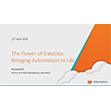
IBM Nearing Quantum Advantage: What It Means for the Future of AI

(Image source: IBM)
IBM made headlines recently with a major announcement: the company is only two years away from achieving quantum advantage. This milestone could transform industries and redefine the future of artificial intelligence. This announcement, made at a recent analyst briefing, puts IBM at the forefront of a technological revolution that promises to merge the power of quantum computing with the potential of generative AI.
Quantum Advantage vs. Quantum Supremacy
To understand the significance of IBM’s announcement, it’s crucial to distinguish between quantum supremacy and quantum advantage.
Quantum supremacy refers to the moment when a quantum computer can solve a problem that is practically impossible for a classical computer to solve in any reasonable time frame. Google claimed this milestone in 2019 when its quantum processor solved a problem in 200 seconds that would take a supercomputer thousands of years, though the usefulness of that problem was minimal.
Quantum Advantage, on the other hand, is a more practical and commercially significant milestone. It’s the point at which quantum systems consistently outperform classical computers on useful tasks. According to IBM’s roadmap, this means quantum processors will soon be used to solve real-world problems faster, cheaper, or more efficiently than traditional machines.
Why Quantum Advantage Matters for Generative AI
Generative AI—systems that can produce text, images, audio, and code—relies heavily on vast amounts of computation. Training large language models like GPT or IBM’s Watson X involves handling massive datasets and performing calculations across billions of parameters. This process is resource-intensive, time-consuming, and incredibly expensive.
Quantum computing has the potential to revolutionize this process. Quantum systems can process information in fundamentally different ways, leveraging superposition and entanglement to perform multiple computations simultaneously. This parallelism could:
- Accelerate model training by optimizing data flows and parameter updates.
- Improve inference speeds, making AI systems faster in real-time interactions.
- Enhance optimization algorithms used in everything from language modeling to autonomous systems.
As researchers from MIT and IBM have noted, early experiments with quantum machine learning are already showing promise in improving neural networks and probabilistic models.
A Path Toward Artificial General Intelligence (AGI)
The arrival of Quantum Advantage could also bring us closer to Artificial General Intelligence (AGI). AGI refers to AI systems that can learn, understand, and apply knowledge across a wide range of tasks—matching or exceeding human cognitive abilities.
AGI remains a long-term goal, but quantum computing could act as a catalyst in several areas:
- Massive parallel data processing would enable models to mimic brain-like functions more effectively.
- Complex system simulation, including those mimicking neurological processes, could be vastly accelerated.
- Real-time learning and adaptation could become more feasible as quantum processors enable on-the-fly model updates.
These advantages could dramatically increase the scope and depth of generative AI capabilities, allowing machines to learn from sparse data, adapt to novel contexts, and reason in more abstract ways.
IBM’s Watson X + Quantum: The Ultimate AI Platform?
IBM has already invested heavily in AI with its Watson X platform, which integrates data governance, machine learning, and generative AI tools into a cohesive development environment. If Quantum Advantage is achieved within the next two years as IBM predicts, integrating quantum processing into Watson X could create the most powerful AI solution on the market.
Here’s what that might look like:
- Quantum-enhanced model training could drastically reduce the time needed to deploy new AI solutions.
- Scalable quantum simulations could aid industries like pharmaceuticals, finance, and materials science in developing highly accurate, AI-driven predictions.
- Real-time decision systems could benefit from Watson X’s orchestration capabilities combined with the raw power of quantum-enhanced computation.
The combination of quantum computing and AI would also elevate the role of Watson X in competitive enterprise environments, allowing it to tackle more complex workflows and outperform rivals in speed, flexibility, and intelligence.
Wrapping Up: The Coming Quantum-AI Era
With IBM charting a path toward Quantum Advantage and committing to integrate quantum solutions into its AI stack, the fusion of quantum computing and generative AI is no longer theoretical; it’s inevitable. This convergence could usher in a new era of innovation where machines not only think faster but also reason deeper.
As we approach 2026, all eyes will be on IBM. If it delivers on its promise, the ripple effects will redefine AI development, enterprise computing, and possibly even human-computer interaction itself. One thing is sure: the future of AI will be powered by quantum.
About the author: As President and Principal Analyst of the Enderle Group, Rob Enderle provides regional and global companies with guidance in how to create credible dialogue with the market, target customer needs, create new business opportunities, anticipate technology changes, select vendors and products, and practice zero dollar marketing. For over 20 years Rob has worked for and with companies like Microsoft, HP, IBM, Dell, Toshiba, Gateway, Sony, USAA, Texas Instruments, AMD, Intel, Credit Suisse First Boston, ROLM, and Siemens.
global companies with guidance in how to create credible dialogue with the market, target customer needs, create new business opportunities, anticipate technology changes, select vendors and products, and practice zero dollar marketing. For over 20 years Rob has worked for and with companies like Microsoft, HP, IBM, Dell, Toshiba, Gateway, Sony, USAA, Texas Instruments, AMD, Intel, Credit Suisse First Boston, ROLM, and Siemens.
Related Items:
Correcting an AI Overreaction On DeepSeek, and Emphasizing the Importance of Quality
The Coming Catastrophic Failure Of AI In Business
DeepSeek R1 Stuns the AI World





























